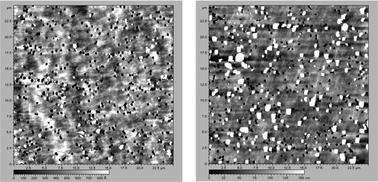During the 2002–2003 austral summer field season, aerosol samples were collected at a coastal (Terra Nova Bay—Northern Victoria Land) and an inland site (Dome C—East Antarctic Plateau). The sampling was carried out by stacked filter units made up of two filters at different porosity (5.0 and 0.4 μm at Terra Nova Bay and 3.0 and 0.4 μm at Dome C), able to roughly separate a coarse from a fine fraction. At Dome C, a further investigation on aerosol size distribution was performed by an inertial impactor able to collect aerosol particles on 8 size classes (from 10 to 0.4 μm). Atomic Force Microscopy was applied to the filter collecting the finer fraction in both sites in order to assess the real cut-off value of the filter sandwich apparatus and to reconstruct the volume size distribution. At the employed flow conditions, the real cut-off value was revealed to be about one third with respect to the filter nominal porosity in both stations. The size distribution plots showed a bimodal distribution with a mode centered around 0.22 μm in both the sites and a second broader mode which is centered between 0.3 μm and 1.2 μm diameter at Terra Nova Bay and shifted toward higher values (centred around 1.0 μm diameter) at Dome C. Each filter was analysed for the main and trace ionic components allowing evaluation of the contributions of primary and secondary aerosol sources at the two sites as a function of the particle size class. The coastal site is mainly affected by primary and secondary marine inputs: the sea spray contribution (Na+, Mg2+, Cl− and ssSO42−) is dominant (77% w/w) in the coarse fraction whereas the biogenic source (methanesulfonate and nssSO42−) prevails (67.5% w/w) in the fine fraction. In this fraction a significant contribution (15.5% w/w) is provided by ammonium likely to be related to surrounding penguin colonies. Dome C atmosphere is characterised by fine particles arising from secondary sources and long-range transport processes. The main component in the fine and coarse fractions at Dome C is sulfate whose nssSO42− represents the 99.5% and the 92.3%
(w/w) in fine and coarse fraction, respectively. The observed agreement between nssSO42− and methanesulfonate temporal profiles in the fine fraction demonstrates that biogenic emissions dominate the inland background aerosol. Results from the sampling by the 8-stage impactor at Dome C are presented here: chloride and nitrate are mainly deposited on the 10–2.1 μm stages while the highest sulfate concentration was found in the submicrometric fraction which turned out to be the most acidic. Such a distribution is able to prevent nitrate and chloride re-emission as gaseous HCl and HNO3 in the 10–2.1 μm stages, arising from the exchange reaction between chloride and nitrate salts and sulfuric acid. Moreover, the concentration peak observed for nitrate in coarser fractions is probably related also to the formation of hygroscopic NH4NO3 particles and nitrate adsorption on sea salt particles.

You have access to this article
 Please wait while we load your content...
Something went wrong. Try again?
Please wait while we load your content...
Something went wrong. Try again?


 Please wait while we load your content...
Please wait while we load your content...